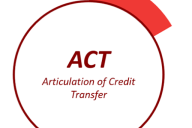You have /5 articles left.
Sign up for a free account or log in.
While Michigan is synonymous with mobility when it comes to manufacturing vehicles of all shapes and sizes, every Michigander knows that a car is only as good as the road it is driven on—and we also know that many of Michigan’s highways have fallen into disrepair. Governor Gretchen Whitmer famously ran on a campaign promise to “fix the damn roads,” and today, orange barrels are sprouting seemingly everywhere in response.
Similar to our roads and bridges, the pathways between our colleges and universities have often been marked with potholes, roadblocks and lane closures. Misalignment between courses, accumulation of excess credits and seemingly dead-end degree options have impeded momentum for students aspiring to transfer for too long. Break out the orange barrels—we’re fixing the damn transfer pathways!
Establishing a Substrate
Historically, Michigan’s transfer infrastructure rested on individual articulation agreements between its constitutionally autonomous community and tribal colleges, public universities, and independent colleges and universities, creating a patchwork of arrangements that varied widely from region to region.
That began to change in 2012, when the Michigan Legislature included language in that year’s community college appropriations bill to prod colleges to improve students’ ability to transfer core courses by reviewing and revising the then-current Michigan Association of Collegiate Registrars & Admissions Officers (MACRAO) Transfer Agreement, untouched since the early 1970s.
A statewide committee, led by the newly established Michigan Center for Student Success (MCSS) at the Michigan Community College Association, and including legislators and representatives from public community colleges and universities, developed a set of recommendations for the Michigan Transfer Agreement, known as the MTA. This 30-credit block of courses satisfies most, if not all, general education requirements and went into effect in fall 2014.
Adding Layers
With the foundation of a general education core in place, the Legislature turned its attention in 2017 to investing in a set of multi-institutional agreements in popular majors. The MiTransfer Pathways combine foundational courses in each discipline, the MTA and the balance of credits required to complete an associate degree in 10 areas of study. Currently, all the state’s community colleges and public universities, as well as 18 independent colleges and universities, participate in one or more of the pathways.
The pathway agreements, along with the MTA, are maintained through the oversight of a Transfer Steering Committee which includes representation from community colleges, public universities and independent institutions. This effort is supported by another key state investment, the Michigan Transfer Network (MTN) portal which allows users, including students, to research the transferability of courses across the state.
Using the lessons learned from building the MiTransfer Pathways, the MCSS has been partnering with national funders, researchers and faculty and administrators across the state to improve opportunities for students who begin their education at community colleges to earn bachelor’s degrees in the humanities, in workforce programs and at independent colleges and universities. And improvement is needed.
Potholes, Roadblocks and Lane Closures
Recent analysis from the Community College Research Center (CCRC) revealed that rates of transfer and bachelor’s degree completion among students who begin at a community college are inequitable and quite low. While as many as 80 percent of new community college students across the country aspire to earn a bachelor’s degree, only 42 percent of incoming community college students in Michigan ever transfer to a four-year institution, and only 10 percent complete a bachelor’s degree within six years of entry. Rates for Black and Hispanic students are even lower. Those students who do complete the bachelor’s degree typically do so with about 30 excess credits.
Misalignment of courses designed for transfer, a lack of cohesive curricula at the community college level, and gaps in inter-institutional communication that can lead to inconsistent student guidance have all contributed to these disappointing transfer outcomes.
Within community colleges, some programs of study are loosely defined, especially in the humanities, or were never designed to lead to transfer, as in the case of applied associate degrees. Michigan’s decentralized higher education environment doesn’t always make things easier, and leaders in the transfer field have learned to rely on “coalitions of the willing” to move initiatives forward.
Work Zones
The MCSS, along with various state and national partners, is currently leading three initiatives focused on improving transfer: Strengthening MiHumanities, Strengthening MiWorkforce Pathways and Liberal Arts Pathways From Community Colleges to Independent Institutions. These programs, supported by four different national funders, all build on the infrastructure of CCRC’s Guided Pathways, a whole-college reform framework that smooths students’ passage into and through community college systems. While all of the programs emphasize the importance of improving student mobility between institutions, each puts its own unique spin on the effort.
Funded by the Mellon Foundation, Strengthening MiHumanities was designed to build on previous statewide efforts to build and strengthen transfer pathways. The project explores the potential of faculty engagement and voluntary agreements to advance a goal of encouraging more community college students to earn bachelor’s degrees in a humanities field. MCSS convened faculty and administrators from 25 community colleges and 25 bachelor’s degree-granting institutions in the disciplines of communication, English, history and theater for a series of Pedagogy for Peers workshops and discipline dialogues, while research partner CCRC analyzed quantitative data and conducted qualitative interviews to uncover examples of efforts in Michigan to create more coherent and effective pathways to transfer in the humanities and engage in onboarding practices that help students explore and connect to a humanities field or program early in their college career.
Strengthening MiWorkforce Pathways is a multiphase initiative funded by the Ascendium Education Group to improve outcomes for students in community college workforce programs. The project emphasizes the redesign of workforce programs to promote more equitable participation and outcomes, embedding industry-recognized credentials in programs and creating new transfer agreements that will make it easier for community college students to seamlessly transfer to four-year institutions to complete their bachelor’s degrees in the areas of general applied science, applied business, health care and information technology.
Liberal Arts Pathways From Community Colleges to Independent Institutions leverages Michigan’s investments in improving transfer to increase coordination and collaboration between community colleges and independent institutions. With funding from the Teagle and Arthur Vining Davis Foundations, the MCSS and its partner organization, the Michigan Independent Colleges and Universities (MICU), have provided customized support for independent colleges to participate in the MTA, sign onto the MiTransfer Pathways agreements and share data on course and program transferability via the MTN.
New Traffic Pattern Ahead
Each individual transfer initiative leverages the tools that Michigan has developed in the past decade to modernize and streamline student transitions between associate and bachelor’s degrees, including the MTA, the MTN and the MiTransfer Pathways framework. And Michigan is starting to see results from these efforts.
A new report from CCRC on the Strengthening MiHumanities initiative, presents some promising trends in community college student course enrollments, transfer and bachelor’s degree completion in a wide array of humanities fields and the liberal arts along with findings from interviews with faculty, staff and students. The report highlights promising approaches to strengthening humanities transfer outcomes in Michigan, including organizing programs into premajors, creating new or strengthening pathway-specific transfer agreements, and supporting robust career exploration for students. The MCSS has also published a series of MiHumanities Roadmaps, which offer recommendations for Michigan institutions and state actors to improve transfer in the four focal MiHumanities disciplines.
As part of Strengthening MiWorkforce Pathways, in fall 2023 25 community colleges joined new transfer agreements with 10 four-year colleges and universities across Michigan. Collectively, the agreements include 529 associate degree programs offered by community colleges and 44 bachelor’s degrees at four-year institutions. Examples of associate degrees included are manufacturing engineering technology, hospitality management, cardiac sonography and cybersecurity.
As a result of the increased opportunities for coaching and collaboration offered by the Liberal Arts Pathways From Community Colleges to Independent Institutions initiative, an increasing number of independent institutions are participating in the MTA, MTN and one or more of the MiTransfer Pathways. The MCSS and MICU will host a Liberal Arts Transfer Summit in July 2023 to publicize and celebrate the project’s achievements.
While Michigan has strengthened the infrastructure for student mobility with state investments in general education, pathways to majors and an online portal, these initiatives amply demonstrate that the work of pathway construction and repair, along with student guidance, requires time and attention from faculty, advisers and administrators at both community colleges and bachelor’s degree-granting institutions. In the absence of a state agency or legislative mandate, this labor is voluntary, but still essential. Perhaps the biggest impact of all of the investments in improving transfer in Michigan is the increasing level of conversation and collaboration across the state that keep students and institutions moving on the highways, byways and pathways of higher education.
Jenny Schanker is the senior director of learning and research at the Michigan Center for Student Success. She has been leading student success initiatives at the Michigan Community College Association since 2011.


